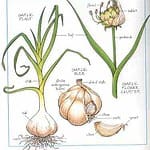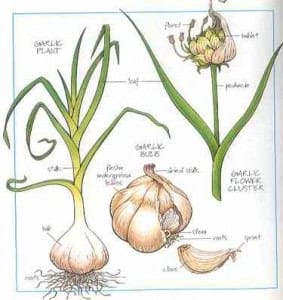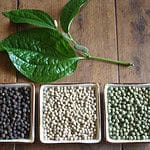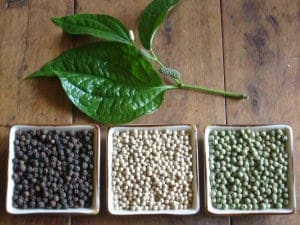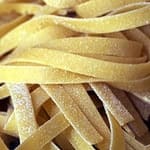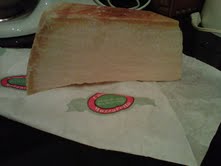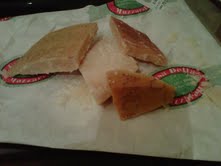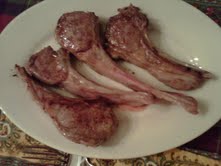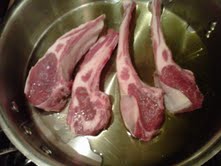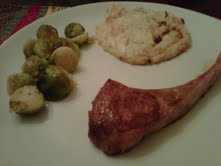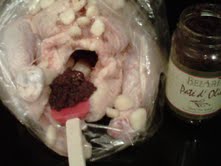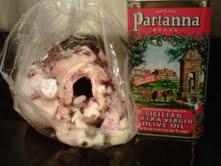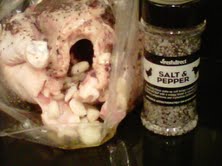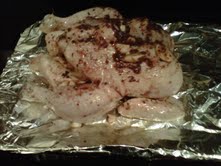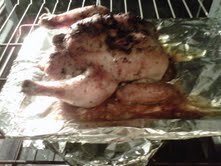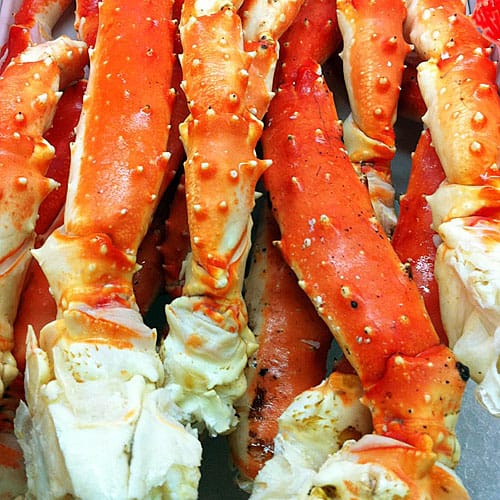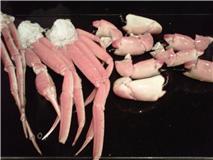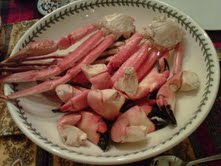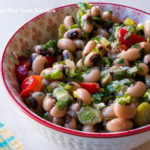Know Your Chicken
Broiler-Fryers: Tender young birds that usually weigh 3 to 5 pounds. They can be roasted, fried, sautéed, grilled or broiled.
Roasters: Meaty birds that usually weight 6 to 8 pounds and are best when roasted.
Cornish Hens: Small birds that weigh up to 2 pounds each. They are tasty grilled, broiled and roasted.
Fowl: Also called stewing hens. These tough older birds are available especially around the holidays. They are always braised or stewed and make the best chicken stock.
Capons: Neutered male chickens that weigh 8 to 10 pounds on average. They are very meaty and tender and are usually roasted.
Poultry Shopping
Organic: The term organic has legal weight and the USDA enforces it. 100 % of the feed (except maybe for mineral supplements) must be certified organic which means that is has been grown in a field that has not seen chemical fertilizers, fungicides, herbicides or genetically modified organisms for at least three years. Certain husbandry techniques are prohibited in organic production. Since antibiotics are not allowed at all, chickens can’t be contained in the wing to wing density that conventional producers use (with that cramming it would be impossible to keep disease at bay without drugs). By law, organic chicken also has to be “free range.”
Free Range: These birds have been raised in an environment that provides access to open spaces, but not necessarily an open farmyard. This free movement allows them to develop more muscle which contributes to fuller flavored meat. Free range does have an official definition: “Producers must demonstrate to the Agency that the poultry has been allowed access to the outside.”
All Natural: This simply means that poultry has been minimally processed. Its feed was not necessarily organic and might have contained antibiotics.
Kosher: Kosher birds have been processed according to Kosher dietary laws under the strict supervision of a rabbi. The procedure includes salting to draw out the blood and season the meat.
Halal: If you live in an area that has a Muslim community, there is probably a Halal butcher. These birds are not fed hormones and are slaughtered manually while a special prayer is recited.
Garlic Guide
Allium Sativum, commonly known as garlic, is a species in the onion family Alliaceae. Its close relatives include the onion, shallot, leek, chive and rakkyo. Garlic has been used throughout history for both culinary and medicinal purposes. Garlic is easy to grow and can be grown year round in mild climates. In cold climates, cloves are planted in the ground in the fall and harvested in late spring.
The world’s top garlic producers are:
- China
- India
- Egypt
- Russia
- United States (Gilroy, CA)
- Spain
- Argentina
- Myanmar
- Ukraine
The edible bulb is made up of sections called cloves. When selecting garlic choose firm, plump bulbs with dry skins. Avoid soft or shriveled cloves and garlic that is stored in the refrigerated section of the produce department. It is best to store fresh garlic in an open container in a cool, dark place. Unbroken bulbs can be stored up to 8 weeks. Once broken from the bulb, individual cloves will keep 3 to 10 days.
When cooking with garlic you can grate it, crush it, chop it, press it, puree it, mince it or roast it. Garlic matches well with beans, beef, beets, cabbage, chicken, eggplant, fish, lamb, lentils, mushrooms, pasta, pork, potatoes, rice, shellfish, spinach, tomatoes, and zucchini.
1 Clove = 1 Teaspoon Chopped Garlic
American: White Skinned & Strong Flavored
Italian: Purplish Skin & Slightly Milder Than White Skinned Garlic
Mexican: Similar To Italian Garlic, Purplish Skin & Milder Than American Garlic
Elephant: Not A True Garlic, But A Member Of The Leek Family. It Has A Rather Tame Garlic Flavor. With A Bulb The Size Of A Grapefruit, It Is Sometimes Sold By The Cove.
Garlic Shoots/Scapes: These Green Shoots, Which Resemble Chives, Are The Stems Of An Immature Garlic Plant. They Have A Mild Garlic Flavor And Can Be Used Raw Or Cooked.
Green Garlic: Garlic That Has Been Harvested Just Before It Begins To Form Cloves.
Peppercorns
Pepper has been used to flavor food for hundreds of years. Peppercorn berries grow in clusters on a plant that is native to India and Indonesia. Whether peppercorns end up being black, white or green depends upon how they are processed. Black peppercorns are picked when the berries are not quite ripe, and then dried until shriveled and brownish black. White peppercorns are picked ripe, then skinned and dried. They are smaller and milder than black peppercorns. Green peppercorns are soft, under ripe berries and are usually processed in brine. They have a fresh, mild flavor. Whole black and white peppercorns can be stored in a cool, dark place for up to a year.
Tips To Jazz Up Pasta Dishes
- Try slivered sun dried tomatoes to dress up your pasta dish. A good addition to macaroni and cheese.
- A tablespoon or two of capers will perk up your dish.
- Add pitted & chopped olives.
- A minced anchovy is a nice addition for the adventurous.
- Freshly grated lemon zest is great for a cream sauce dish.
- Mushrooms add a rich flavor.
All you need are four organic lamb chops, a little salt & pepper, olive oil and some balsamic vinegar. Heat a fry skillet with olive oil, place the chops in the heated oil, salt & pepper and splash a bit of balsamic vinegar over the chops. Turn once and cook for a minute or two, but don’t overcook unless you like your chops well done. Tender and good. A very quick meal. Great to serve with potatoes and brussel sprouts. Serves 2
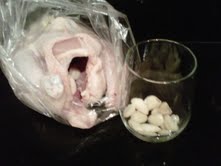 A great way to cook chicken is by marinating overnight. You will be happy that you planned ahead on this one.
A great way to cook chicken is by marinating overnight. You will be happy that you planned ahead on this one.
1. Wash a whole chicken and dry with paper towels.
2. Place chicken in plastic storage bag.
3. Stuff with cut garlic cloves under the skin, inside and all around the chicken. The more garlic the better.
4. Add chopped black olives if you like olives and have them around.
5. Add olive oil.
6. Add salt & pepper. I like the Fresh Direct coarse salt & pepper mixture.
7. Close up the plastic bag. Place another storage bag over the bagged chicken. Added protection from leaking.
8. Shake and massage a bit to ensure that the chicken is covered in yummy garlic goo.
9. Place in the fridge over night.
Next Day Getting Ready To Roast At 350 Degrees For Approximately 1 Hour 15 Minutes Or Until Done
Baking in the oven
 Tiny New York Kitchen wants to wish you and your family a very Happy New Year! We have been posting recipes and talking to our hungry friends out there for only two months now and have received 8,547 visitors so far. The amount of traffic is wonderful and we are thankful to be able to share our love with all of you!
Tiny New York Kitchen wants to wish you and your family a very Happy New Year! We have been posting recipes and talking to our hungry friends out there for only two months now and have received 8,547 visitors so far. The amount of traffic is wonderful and we are thankful to be able to share our love with all of you!
Happy 2011 From Tiny New York Kitchen!
How To Cook Crab Legs
Aren’t sure how to cook crab legs? There are several methods available. Choose a cooking method based on your recipe or your level of cooking expertise.
- Microwave: If you are a beginner and have crab legs that you want to cook and serve easily, simply cook them in the microwave. To do this, place a few wet napkins or paper towels on top of the crab. Cook them for about three minutes at full power.
2. Boiling: If you have a little more time to cook the crab legs and you want to add your own seasonings, using the boiling method. Boil a pot of water and add the crab legs once the boil begins. After dropping them in the pot, turn down the heat to a simmer for a few minutes. The length of time will likely depend on the size of the crab legs and how many you are boiling. Add your own seasonings while the crab legs simmer.
3. Steaming: This method is only slightly more complicated and it is often considered the best method to cook crab legs. Place a steaming insert inside of a pot, fill with water, boil and place the crab in the steaming insert. The steam should only take about five minutes to cook the crab legs. If you don’t have a steaming insert you may use a colander or anything else that will allow the steam to heat the crab.
4. Grilling: Grilling is a great way to cook crab legs. To do this, just lay the crab on the grill with the shell facing down. Cook the crab legs like this for about five minutes. During this time, brush the crab with melted butter or sprinkle on the spices that you prefer



